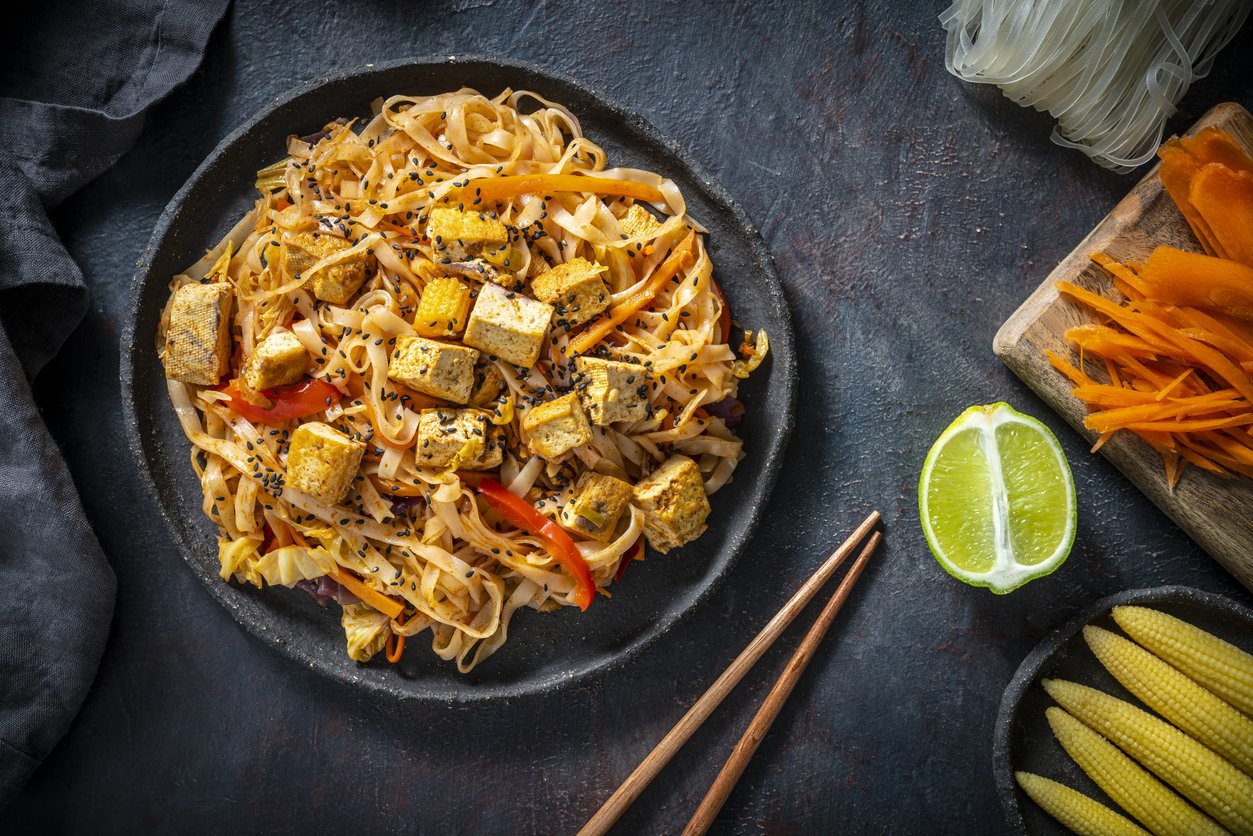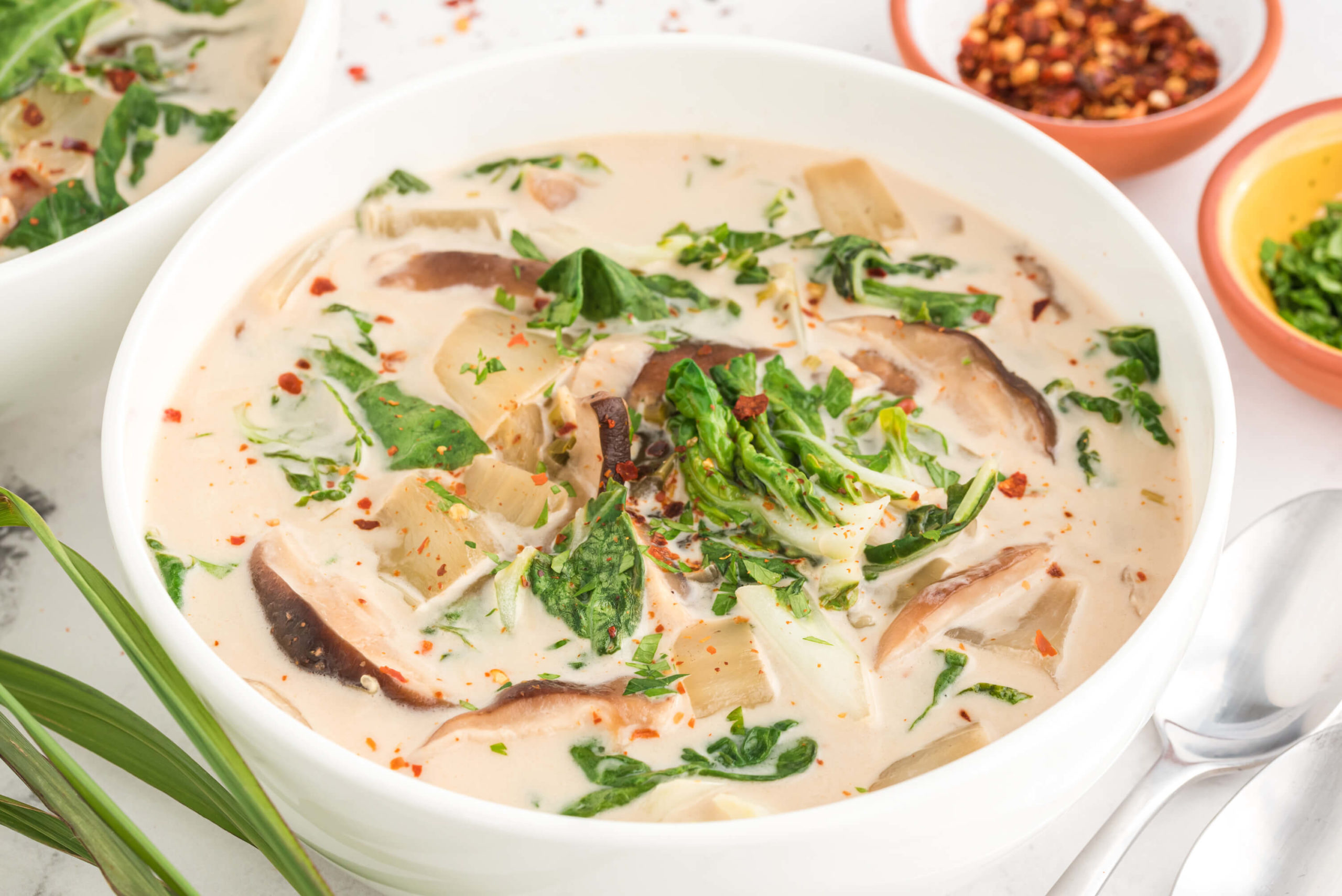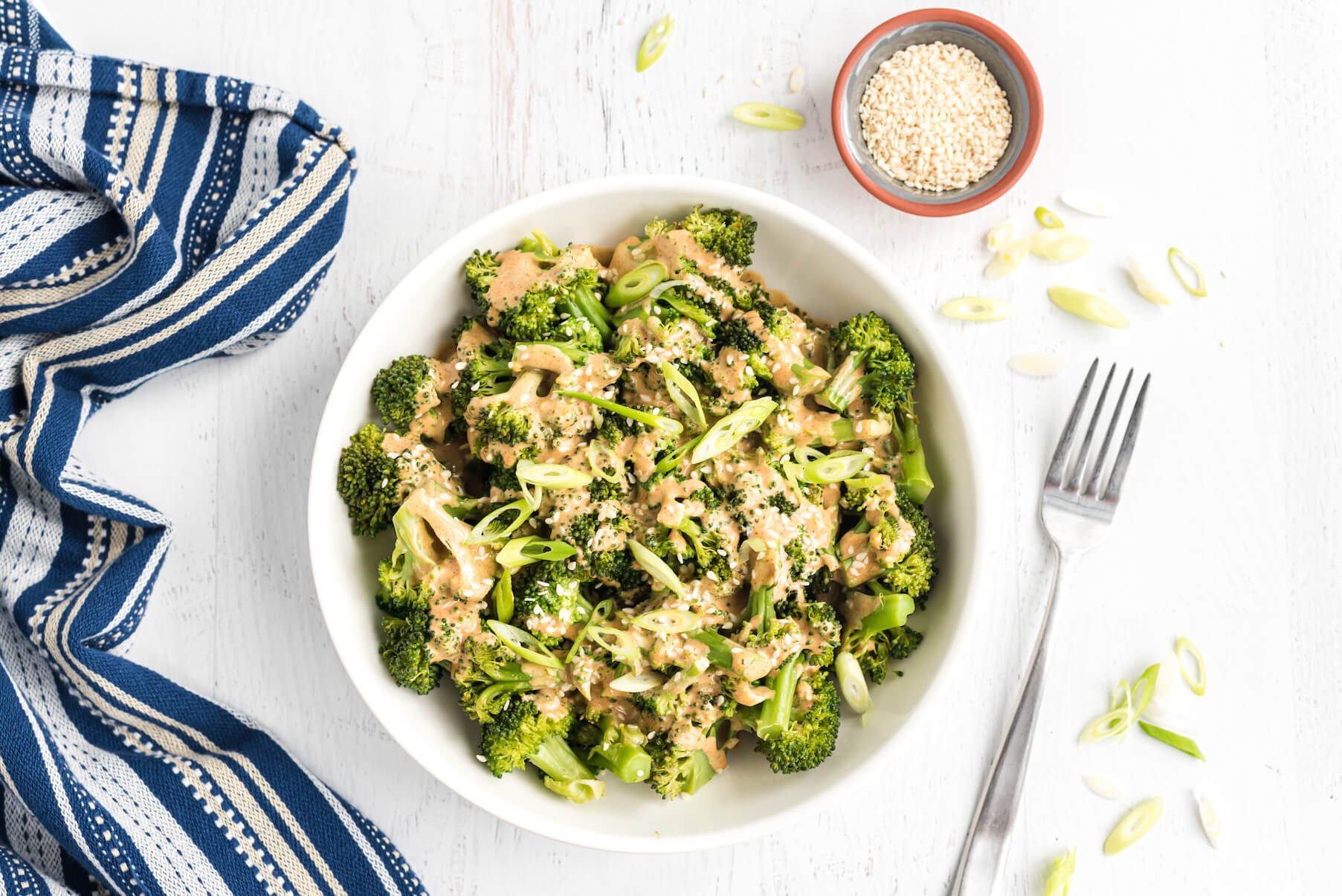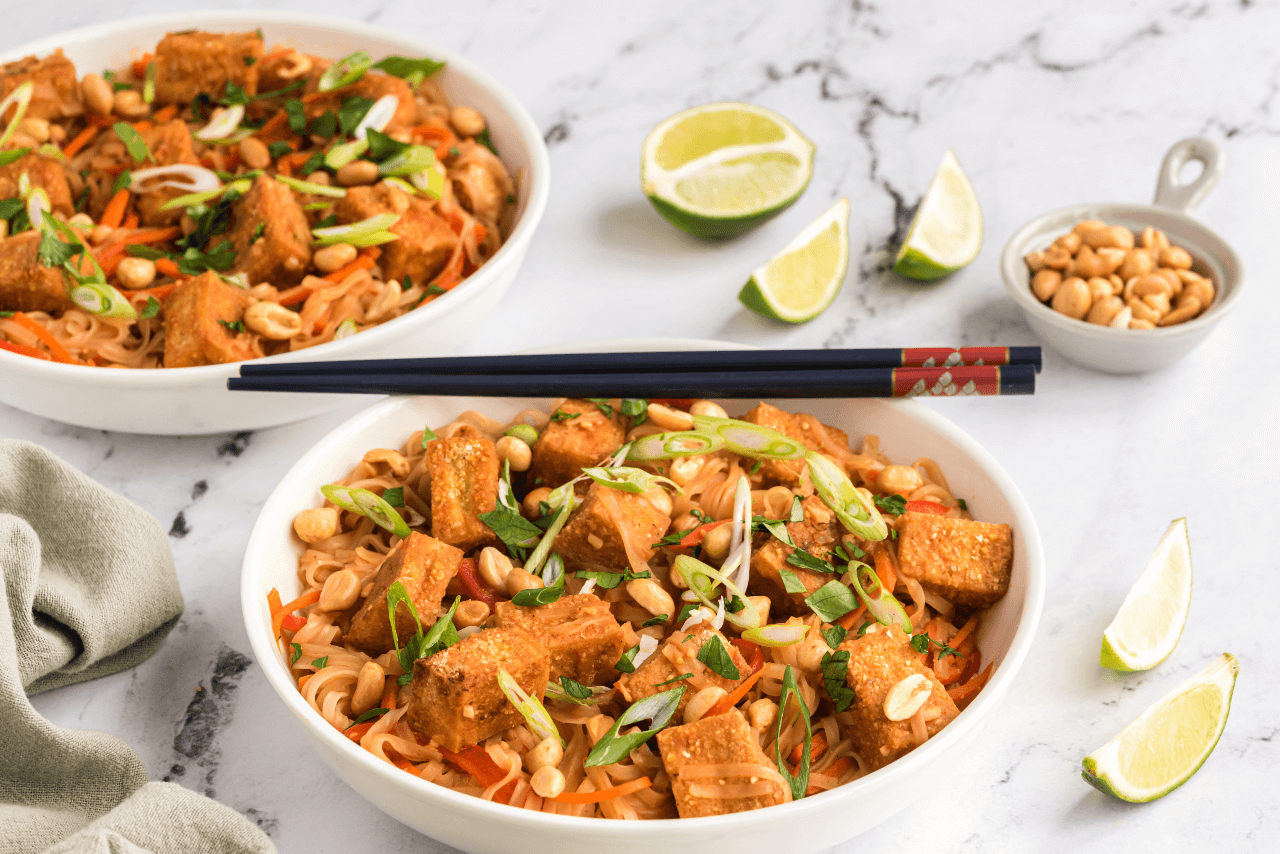A common question received by plant-based eaters is, “Isn’t it difficult to eat out?” The short answer is no. It’s actually quite easy (and exciting!) if you treat it like a fun treasure hunt.
However, certain types of restaurant cuisines are friendlier to plant-based eaters than others. And today, we’re going to talk about one of them: Thai food.
When visiting a Thai restaurant, diners often have the welcome dilemma of having many options that are adaptable to suit plant-based eaters. And with over 10,000 Thai restaurants in the US alone, it’s pretty darn easy to enjoy eating Thai food.
Thanks to the Thai government using food as a gateway to globalization (a concept known as gastro-diplomacy), Thai food has become more prominent and popular than ever. In fact, pad thai was originally developed because of a rice shortage — it wasn’t even a significant cultural dish to begin with. And those tasty noodles opened the floodgates for Thai food’s entrance into Western culture.
With the development of the Global Thai program, trainings, grants, and information were provided to Thai investors who wanted to open restaurants abroad. It also standardized what diners could expect on Thai restaurant menus. If you’re a Thai food lover, this may explain why you often see the same options at any Thai restaurant you visit, no matter the location.
So how do you replicate the flavors and dishes that make Thai food, Thai food? What ingredients are essential? And what Thai dishes are already free from animal products, or only require minimal changes?
If you’re a Thai food fan and want to enjoy some of the most popular dishes in your own kitchen, or if you’re looking to expand your palate, read on to discover how to create vegan Thai recipes (or Thai-inspired dishes).
What Makes Thai Food Unique
Thai food is unique in that it includes a five-flavor profile: sweet, salty, spicy, bitter, and sour. You could have a whole meal with each of these tastes: a sweet salad, spicy curry, sour soup, salty noodles, and bitter greens tossed in a stir-fry.
Thai food also stands out because of the merging of different flavors and ingredients due to the country’s geography and influence from neighboring countries.
According to May Kaidee, vegan Thai food restauranteur and author of May Kaidee’s Thai Vegetarian and Vegan Cookbook, Thai cuisine is classified into four regions: Northern, Northeastern, Southern, and Central.
Says Kaidee, “Northern Thai dishes include the well-known Khao Soi, a noodle dish bathed in a curry soup base. This region is known as Lanna, and the dishes trace their origin to the ancient Kingdom of Lanna from several hundred years ago.
Northeastern Thai food is heavily influenced by Laotian cuisine, as this region of Thailand has a large population with historic roots in Laos. Known as “Isaan,” cooking in this region makes liberal use of dill, the only region to do so. Dill is, in fact, casually referred to as “Laotian Cilantro,” whereas many Thai dishes in the other regions of Thailand use what is commonly known as cilantro or coriander. Isaan cooking is also influenced by Cambodian cuisine since Cambodia also borders part of Northeastern Thailand.
Southern Thai food is influenced by neighboring Malaysian and Indonesian cooking, all with traditions originating in countries with majority Muslim populations. Many, if not most, of Thai curries come from Southern Thailand. Dishes from this region make generous use of coconut, and use ingredients such as potatoes which are not as common in dishes from other regions.
Central Thailand (Editor’s Note: Where capital city Bangkok is located) is where most of the Thai dishes with worldwide popularity come from. These include Pad Thai (which is actually a young dish relative to the history of Thailand) and green curry. In most countries outside of Thailand when people mention Thai food, they’re usually referring to Central Thai cooking. However, by no means are the dishes better than those from other regions, they’re just better known. Cooking from all of Thailand’s regions is equally good, and collectively, they make for a diverse and complex cuisine.”
No matter what the region, however, Thai food has several core ingredients that make it recognizable, adaptable, and relatively easy to replicate. As a result, it’s approachable for many dietary preferences, including plant-based eating.
Thai Cuisine Essentials
Before we dive into tasty Thai creations, let’s talk about what you’ll need to create a more authentic experience.
Meal base:
- Jasmine rice (a fragrant long-grain rice)
- or rice noodles (used in dishes like Pad Thai)
Protein:
Traditionally, many Thai dishes often include either chicken, pork, or seafood. But you can easily sub in a meat analogue or plant-based foods such as:
- Tofu
- Jackfruit
- Mushrooms
Condiments:
- Coconut milk (used in curries, soups, and desserts)
- Tamarind (a sweet, tangy fruit that is blended into a paste)
- Red, green, and yellow curry pastes
- Lime (an acidic addition to salads, soups, and sauces)
- Peanuts (crushed and sprinkled on top of meals or used in sauces to create a nutty flavor and creamy texture)
- Prik Nam Pla/Fish sauce
To achieve the same umami flavor profile as fish sauce, without harming any fish, you can try soy sauce or tamari instead. You can also make your own vegan fish sauce with mushrooms or seaweed or purchase one premade from Tofuna Fysh or Ocean’s Halo.
Some common herbs and spices used in Thai cuisine are:
- Lemongrass
- Galangal
- Thai chilies or chili paste
- Kaffir lime leaves
- Thai basil
- Cilantro
- Shallots
- Garlic
Indeed, spices may be some of the most important ingredients for replicating Thai dishes at home. “At a minimum, keep a quality chili paste along with galangal and lemongrass; those ingredients can be kept in a freezer for long-term storage,” explains Kaidee.
Some of the more exotic spices may not be available at everyday grocery stores. Look for these spices at health food stores, Asian supermarkets, and South Asian and Indian markets. Many are also available online.
To balance out the sour, spicy, bitter, and salty flavors, a little sweetener may also be added in the form of palm sugar. Unlike ultra-processed white sugar, palm sugar is unrefined and comes from palm tree sap. And unlike palm oil, palm sugar is a more sustainable ingredient choice as trees are maintained for their sap for up to 100 years, and, therefore, not cut down. A suitable whole food substitute for palm sugar is date sugar or date paste.
Vegan Thai Food
Buddhism is the predominant religion in Thailand, and many Buddhists are vegetarian or vegan. The term je or jey, meaning without animal products, is used to describe many Thai dishes that are already vegan or plant-based or can be prepared that way.
But while Thai cuisine and many of its commonly used ingredients may have been more vegetarian or vegan in ancient times, gradually, meat and seafood have become the norm as Thai cuisine has become more Westernized. However, many dishes can still be easily made plant-based. As May Kaidee told us, “Since there is heavy use of fresh herbs, spices, and plentiful amounts of fruit and vegetables in Thai cooking already, the dishes can easily stand on their own when omitting animal products.”
With the omission of meat — or by swapping out meat with plant-based alternatives such as tofu, tempeh, or jackfruit, and replacing fish or oyster sauce with a vegan option — you can still enjoy many of the flavors and dishes popular in Thai cuisine.
If you follow a SOS-free (salt-, oil-, sugar-free) diet, you can also make Thai dishes oil-free by stir-frying in vegetable broth or water and baking rather than deep-frying.
What Thai Dishes Are Plant-Based or Can Be Modified to Be So?
Now that you’re aware of the plant-based nature of Thai dishes and ingredients, let’s talk about which Thai dishes are naturally plant-based and which can easily be modified into plant-based deliciousness when ordering out or making them at home.
- Appetizers:
- Spring rolls or summer rolls (vegetarian options are usually veggies only)
- Tao hu tod/Fried tofu
- Som tam/Papaya salad (omit dried shrimp, crab, or egg)
- Pad Pak Boong/Stir-fried morning glory (omit or replace fish sauce and oyster sauce)
- Nahm prik noom/Green chili dip (some recipes include fish sauce)
- Mains:
- Green curry, panang curry, pumpkin curry, etc. (omit or replace fish sauce; use a plant-based protein of choice)
- Pad Thai with tofu (omit or replace fish sauce; omit egg)
- Fried rice (omit or replace fish sauce; omit egg or use tofu instead; use a plant-based protein of choice)
- Tofu satay (omit or replace fish sauce in peanut sauce)
- Desserts (Many Thai desserts are naturally vegan since they’re made with rice, coconut, and fruit!):
- Mango sticky rice (mango and sticky rice in coconut milk — need we say more?)
- Khanom krok/Coconut pancakes
- Ruam mit (starchy noodles, tapioca pearls, and fruit in a sweet coconut milk syrup)
- Khao lam (naturally plant-based with sticky rice, beans, and coconut cream — yum!)
- Woon Nam Maprao (coconut milk jelly made with agar)
Note that you can also try other entrees not on this list by omitting the meat. Or, when eating out, try looking for a plant-based Thai restaurant in your area. May Kaidee has vegan Thai restaurants in NYC and Thailand (Bangkok and Chiang Mai).
Vegan Thai Recipes
If your mouth isn’t already watering from the helpful tips and tricks above, just wait until the aromas of Thai cuisine begin to fill your home. From our sweet and sour Thai salad to our naturally sweet and humble sticky rice, these recipes are your one-way ticket to Thailand. Buckle up and get ready for a culinary and nutritional adventure of a lifetime!
1. Vegan Som Tam
Vegan Som Tam is our version of the very popular Thai papaya salad, som tam, and is bursting with lots of rich and robust sweet, savory, sour, and spicy notes. Slightly chewy with a nice bite from the shredded papaya, this salad hits nearly every taste and texture, plus it has nutrients galore! Enjoy this wholesome fruit-based salad any night of the week!
2. Tom Kha Soup
You may have heard of Tom Yum, the famous hot and sour soup from Thailand that is traditionally made with shrimp, lemongrass, garlic, and lime. Tom Kha soup is the creamy version of Tom Yum, made with the addition of coconut milk. We’ve substituted mushrooms for shrimp to make it plant-based and to create a creamy, flavorful, and nourishing soup that will bring Thailand to your dining room.
3. Tofu Satay Skewers
One of the most beloved flavors in Thai cuisine has got to be the zingy, sweet, and nutty combination commonly found in satay sauce. Our Tofu Satay Skewers bring the delightful flavors of traditional satay to life with wholesome plant-based ingredients that are every bit as delicious and just as fun to eat. Enjoy these tasty bites as a mouthwatering appetizer or a flavorful addition to your favorite salad, roasted veggie plate, or grain bowl.
4. Drunken Broccoli in Thai Almond Sauce
As the story goes, Thai culture adopted the term “drunken” for dishes that are the perfect cure-all after a party-filled night with friends. In this case, our Drunken Broccoli in Thai Almond Sauce is a delicious way of enjoying broccoli smothered in a slightly spicy Thai almond sauce that is perfect as a side or just as delicious over a wholesome bowl of chewy rice noodles!
5. Tofu Pad Thai
Tofu Pad Thai is a vibrant, flavorful dish that brings the essence of Thai cuisine right to your table with a healthful, plant-based twist. This dish starts with firm tofu, marinated and baked to perfection, offering a wonderfully chewy texture and a protein-rich base. The tofu is then tossed with stir-fried rice noodles, lots of colorful veggies, and the classic sweet and sour pad Thai sauce. Our pad Thai recipe is a hearty and nourishing meal that’s simple to make and even better than takeout.
6. Sweet Chili Broccoli and Tofu
Crispy baked tofu, tender broccoli, and chili sauce add a little sweetness with a kick to our Thai recipe roundup! Spoon all the nourishing ingredients over organic brown rice, mix it with your favorite noodles, or top it with extra Sweet Chili Sauce for more of that somethin’ that makes this Thai dish so special!
7. Sticky Black Rice with Mango
Sticky Black Rice with Mango gets the whole food, plant-based treatment! Inspired by the classic Thai dessert mango sticky rice, this naturally sweet and fiber-rich version is a sumptuous and exotic dessert that captures the essence of the tropical flavors of Thailand in a simple yet indulgent way.
Try Your Hand at Thai!
Whether you’re a seasoned Thai food lover or newly initiated, Thai cuisine offers an enriching and delicious experience that is adaptable to different tastes.
Remember, if you stumble upon a meat-based Thai dish outside of this article, many Thai dishes can easily be made plant-based with one of the substitutions we offered above.
If you’re looking for a little guidance on where to start, try beginning with the Vegan Som Tam (a simple salad), then move on to the soup or skewers before making your way through the mains. No matter which recipe you choose, we hope you enjoy exploring the vast flavors and wonderfully diverse world of Thai cuisine.
Tell us in the comments:
- What’s your favorite Thai dish?
- Which Thai recipe will you make first?
- Which common Thai ingredients might already be in your pantry or fridge?
Featured Image: iStock.com/IriGri8












